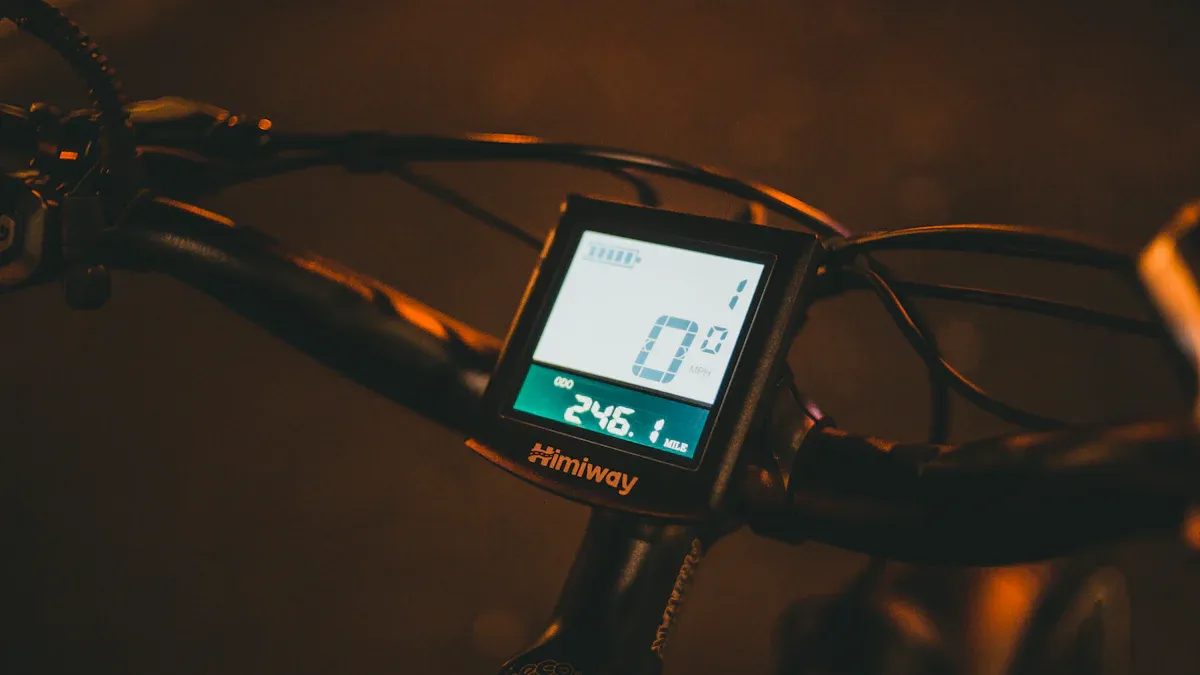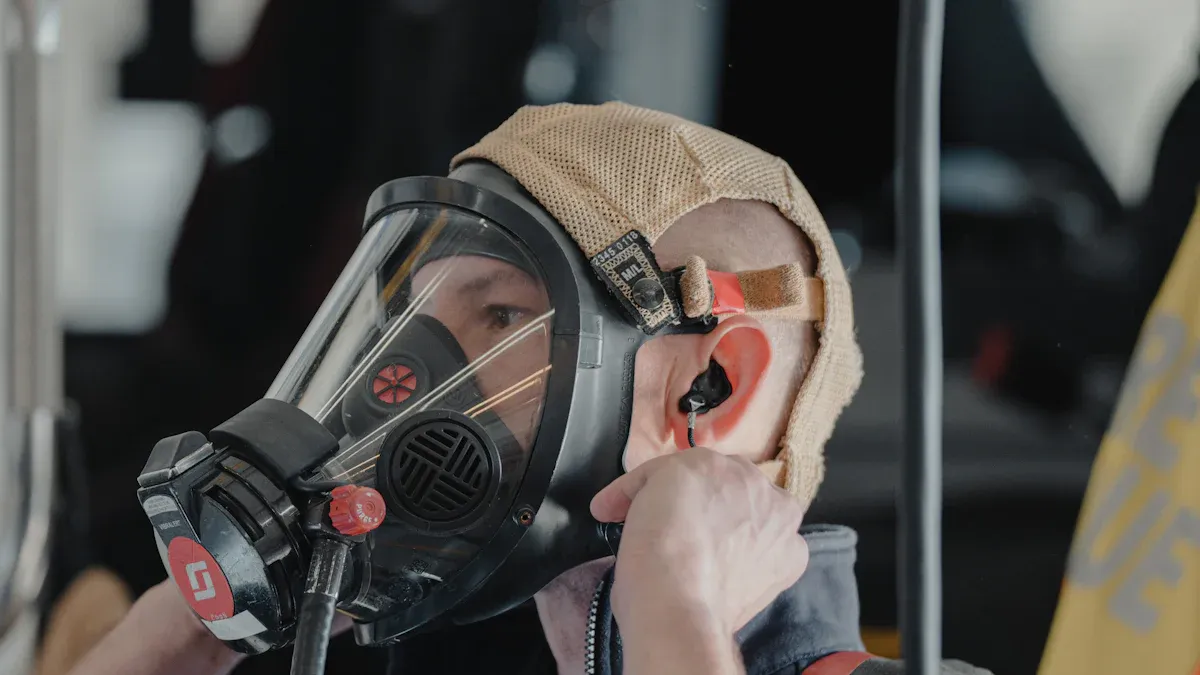
Precision in battery management drives reliability and performance for autonomous mobile robots. You face unique challenges when operating lithium battery packs in dynamic environments. Custom solutions optimize battery efficiency and address unique challenges in robotics. Custom battery management systems deliver the power of precision through:
Precise voltage control that prevents overcharging and undercharging for every battery cell.
Continuous monitoring of temperature and current at both cell and pack levels to mitigate catastrophic failure risks.
Advanced cell balancing, ensuring uniform charging and discharging to maximize battery performance and lifespan.
Custom BMS designs elevate safety aspects and deliver robust protection for robots. You gain confidence in operational safety, reliability, and long-term battery efficiency through tailored custom solutions.
Key Takeaways
Custom BMS solutions enhance battery safety by preventing overcharging and overheating, ensuring reliable operation in robotics.
Real-time monitoring and advanced cell balancing extend battery life and optimize performance, reducing downtime and maintenance costs.
Tailored BMS designs address unique challenges in robotics, providing precise control over voltage, temperature, and current for various battery chemistries.
Implementing predictive maintenance through custom BMS helps avoid catastrophic failures, ensuring operational safety and efficiency.
Meeting industry safety standards with custom BMS designs boosts confidence in the reliability and longevity of robotic systems.
Part 1: Power of Precision in Battery Management

1.1 Precision Monitoring for Robotics
You rely on the power of precision to drive safe, reliable robotics. Precision monitoring forms the backbone of every advanced battery management system. With custom BMS solutions, you gain accurate, real-time insights into state of charge, cell voltage, and temperature. This level of precise monitoring prevents overcharging and over-discharging, which are critical for lithium battery packs in robotics, medical, and industrial applications.
Note: Accurate monitoring enables you to optimize performance, extend battery lifespan, and reduce downtime.
Custom BMS technology uses adaptive charge-discharge optimization and predictive maintenance. These features help you avoid over-stress conditions and minimize battery degradation. Intelligent charge-discharge cycles and temperature control mechanisms further enhance battery longevity.
Impact Area | Findings |
|---|---|
Fast charging can decrease throughput time, but slow charging may outperform it under certain conditions. | |
Charging Policy | Priority charging policy is more cost-effective than dedicated charging policy. |
Optimal Number of Chargers | A decision tool is available to determine the optimal number of chargers for maximum throughput with minimum cost. |
Custom BMS solutions allow you to optimize performance by tailoring monitoring and control to your specific robotics needs.
1.2 Preventing Catastrophic Failure
You face significant risks when managing lithium battery packs in robots. The power of precision in a custom battery management system helps you prevent catastrophic failure by addressing common failure modes:
Challenge | Problem Description | BMS Solution |
|---|---|---|
Battery Degradation Over Time | Aging accelerated by large current draws and environmental stress. | Monitors SoH and usage trends to suggest kinder charging techniques. |
Inaccurate State of Charge Estimation | Unexpected shutdowns due to inaccurate SoC readings. | Combines voltage-based estimation with coulomb counting for increased accuracy. |
Uneven Cell Balancing | Unbalanced cells lead to premature failure and reduced capacity. | Equalizes voltage levels using active or passive balancing. |
Overheating | Heat from high-power actuators affects battery performance. | Uses temperature sensors to initiate power throttling or cooling systems. |
Safety Risks | Overcharging or short circuits can cause fires. | Implements immediate disconnect methods and real-time problem identification to avoid incidents. |
Custom BMS platforms combine real-time monitoring, advanced cell balancing, and immediate fault detection. You can trust these systems to deliver the power of precision, ensuring operational safety and reliability for your robots.
Smart robot battery management systems use predictive maintenance to monitor battery health in real-time.
AI-based BMS platforms lower total cost of ownership and enhance battery life through intelligent cycles and temperature control.
These custom solutions help you optimize performance and energy use, extending cycle life and reducing risk.
Part 2: BMS Functions and Customization
2.1 What Is a Battery Management System
You depend on a battery management system (BMS) to oversee every aspect of your lithium battery packs. A BMS acts as the brain of your power source, especially in robots and automated guided vehicles. It monitors, controls, and protects each cell in your custom lithium battery BMS, ensuring optimal performance and safety.
A custom BMS design manages the charge and discharge cycles, tracks the state of charge, and maintains the state of health for every battery. This oversight prevents overcharging, undercharging, and overheating, which are critical for LiFePO4, NMC, LCO, LMO, LTO, solid-state, and lithium metal chemistries. You gain real-time data on voltage, current, and temperature, which helps you extend battery life and reduce downtime.
Core Function | Implementation Techniques |
|---|---|
Monitoring | Voltage and current monitoring, temperature monitoring |
State of Charge (SoC) | Estimation of remaining capacity of the battery |
State of Health (SoH) | Estimation of overall health and degradation of the battery |
Cell Balancing | Ensures even charging/discharging of individual cells |
Protection Circuitry | Prevents overcharging, over-discharging, and other hazardous conditions |
2.2 Customization for Robotic Needs
You face unique challenges when integrating lithium battery packs into robots and automated guided vehicles. Custom lithium battery BMS solutions address these needs by tailoring every aspect of battery management to your application. Custom BMS design allows you to:
Prevent overcharging, which can cause overheating or explosions in NMC and LCO chemistries.
Use thermal cutoffs that disconnect power if temperatures exceed safe limits, protecting your robots in harsh environments.
Break the circuit instantly in case of a short circuit, preventing fire hazards in industrial and medical robotics.
Fit custom battery packs to the internal geometry of your robots, maximizing space and functionality.
Track state of charge and state of health, enabling predictive maintenance and boosting performance.
Integrate built-in protections like thermal fuses and redundant cutoffs for safe operation in unpredictable scenarios.
A custom lithium battery BMS ensures your robots operate safely and efficiently, no matter the complexity of your application.
2.3 Limitations of Standard BMS
Standard, off-the-shelf battery management systems (BMS) present several limitations when used in advanced robotics, particularly in terms of safety, customization, and long-term sustainability.
You cannot rely on generic BMS for high-performance robots or automated guided vehicles. Standard solutions often lack the advanced monitoring, cell balancing, and protection features required for LiFePO4, NMC, and solid-state lithium battery packs. They do not support custom battery geometries or the specific safety protocols needed in medical, security, and industrial robotics.
Feature/Requirement | Standard BMS | Custom Lithium Battery BMS |
|---|---|---|
Cell Balancing | Basic | Advanced, adaptive |
Fault Detection | Limited | Real-time, predictive |
System Monitoring | Minimal | Comprehensive, application-specific |
Protection Mechanisms | Generic | Tailored to chemistry and use |
Fit for Robot Geometry | Fixed | Customizable |
Performance Optimization | Low | High |
Custom BMS design gives you the flexibility, safety, and performance you need to keep your robots running at peak efficiency.
Part 3: Custom Lithium Battery BMS Features
3.1 Advanced Cell Balancing
You need advanced cell balancing in your custom lithium battery BMS to maximize battery capacity and extend cycle life. In robotics, medical devices, and security systems, uneven charging and discharging can lead to premature failure and reduced performance. Your BMS oversees every charging and discharging process, preventing overcharging and undercharging. Monitoring temperature and voltage at the cell level is essential for prolonging battery lifespan and maintaining health.
Maximizing battery capacity ensures uniform charging and discharging of all cells, preventing overcharging and undercharging.
Improved battery life mitigates risks of overcharging and over-discharging, extending the lifespan of the battery pack.
Increased charging efficiency allows for simultaneous full charge of all cells, reducing charging time and energy losses.
Improved performance consistency ensures stable power output, preventing fluctuations that can damage connected systems.
Feature | Standard BMS | Custom Lithium Battery BMS |
|---|---|---|
Cell Balancing | Basic | Adaptive, chemistry-specific (LiFePO4, NMC, LCO, LMO, LTO, solid-state, lithium metal) |
Charging Efficiency | Low | High |
Cycle Life Extension | Limited | Optimized for robotics, medical, and industrial sectors |
Your custom lithium battery BMS delivers precise cell balancing, which is critical for safety, health, and performance in demanding environments.
3.2 Thermal Management
Thermal management is a vital safety feature in your custom lithium battery BMS. Elevated temperatures degrade battery materials and threaten safety in robotics, infrastructure, and consumer electronics. You benefit from innovative materials like graphene and carbon nanotubes, which enhance thermal conductivity. Hybrid systems combine passive and active cooling strategies, improving reliability and performance.
Recent advancements include heat pipes, phase change materials, and active cooling systems. Heat pipes improve thermal performance, while phase change materials offer passive cooling. Active cooling systems, such as liquid cooling, provide superior heat removal capabilities.
Technique | Effectiveness |
|---|---|
Heat Pipes | Improved thermal performance; ongoing research needed for long-term reliability and optimization. |
Phase Change Materials | Passive cooling; effective in specific scenarios but limited in response time. |
Active Cooling Systems | Enhanced safety and performance; liquid cooling systems show superior heat removal capabilities. |
Effective thermal management prevents thermal runaway in lithium battery packs used in robotics and medical devices.
Monitoring temperature and employing advanced sensors help mitigate risks associated with overheating.
Sophisticated BMS technologies reduce cell stress and damage, preventing catastrophic thermal runaway.
Production Battery Safety Sensors detect early signs of thermal runaway by monitoring volatile organic compounds and other environmental factors.
Your custom lithium battery BMS integrates these safety features to maintain optimal battery health and efficiency.
3.3 Real-Time Fault Detection
Real-time fault detection is a cornerstone of safety and reliability in your custom lithium battery BMS. You rely on digital twins and continuous data collection from battery sensors for real-time monitoring. Immediate detection of anomalies allows you to take swift corrective actions, preventing failures and reducing downtime in robotics, security systems, and industrial applications.
Digital twins provide continuous data collection, enabling real-time monitoring.
Immediate detection of anomalies facilitates swift corrective actions to prevent failures.
Early warnings of potential safety issues, such as thermal runaway, enhance overall battery safety.
Key Aspect | Description |
|---|---|
Real-Time Monitoring | Enables timely detection and diagnosis of faults, minimizing unexpected downtime. |
Predictive Maintenance | Utilizes data-driven methods to anticipate failures before they occur, reducing maintenance costs. |
Advanced Technologies | Incorporates smart sensors and deep learning for accurate fault diagnosis and operational efficiency. |
Your custom lithium battery BMS uses electrical performance testing, thermal analysis, impedance and health analysis, and environmental testing to ensure robust fault detection. Deep learning frameworks, encoder-decoder structures, and cloud-based fault detection modules protect sensitive customer data and minimize data transmission. These safety features deliver unmatched reliability and efficiency.
3.4 Redundancy and Fail-Safes
Redundancy and fail-safe mechanisms are essential safety features in your custom lithium battery BMS. In mission-critical applications such as robotics, medical devices, and infrastructure, you require continuous operation under fault conditions. Built-in redundancy and fault-tolerant design enhance system-level security and maintain operation even during component failures.
Redundancy ensures continuous operation under fault conditions.
Fault-tolerant design maintains system-level security and reliability.
Fail-safe mechanisms protect against catastrophic failure, safeguarding battery health and safety.
Your custom lithium battery BMS integrates multiple layers of safety features, including redundant cutoffs, thermal fuses, and instant disconnect methods. These features guarantee uninterrupted performance and operational safety in the most demanding environments.
Part 4: Ensure Safety and Compliance

4.1 Safety Protocols
You must prioritize safety assurance when deploying lithium battery packs in robotics, medical devices, and industrial systems. Custom BMS solutions provide robust safety protocols that monitor voltage, current, and temperature profiles. These protocols maintain operational limits and prevent hazardous conditions. You benefit from automatic overcurrent protection using electronic components such as fuses and circuit breakers. BMS functions also detect leakage currents and manage battery pack connections and disconnections.
BMS controls battery systems to maintain safe operating conditions.
Real-time monitoring prevents overheating and overcharging.
Automatic disconnection of power contactors during faults enhances safety assurance.
Compliance with international safety standards like IEC 60950-1 and IEC 61850 guides BMS design and communication.
Custom BMS platforms deliver assurance for mission-critical applications in robotics and security systems. You gain confidence in system reliability and safety assurance through advanced monitoring and control.
4.2 Overcharge and Short Circuit Protection
Custom BMS features protect your lithium battery packs against overcharge and short circuit events. Overcharge protection stops the charging process once the battery reaches its safe voltage limit, preventing overheating and explosions. Short circuit protection interrupts the circuit when a fault is detected, avoiding fire hazards and damage to your robotic systems.
Feature | Custom BMS | Standard BMS |
|---|---|---|
✅ | ✅ | |
Short-Circuit Protection | ✅ | ✅ |
Cell Balancing | ✅ | ❌ |
Temperature Monitoring | ✅ | ❌ |
Fault Diagnosis | Advanced | Limited |
You rely on real-time monitoring to ensure safety and optimize battery performance. Custom BMS solutions provide assurance for medical, infrastructure, and consumer electronics applications by reducing risks and extending battery life.
4.3 Meeting Industry Standards
You must meet strict industry standards to guarantee safety assurance and reliability in robotics and industrial sectors. Custom BMS designs comply with UL and IEC standards, which set benchmarks for electrical safety and system integrity.
Standards | Description |
|---|---|
UL | Underwriters Laboratories standards for safety assurance. |
IEC | International Electrotechnical Commission standards for electrical safety. |
Custom BMS platforms integrate overcharge protection, thermal cutoffs, and short circuit protection to meet these requirements. You also address sustainability and ethical sourcing by following conflict minerals guidelines (see statement) and adopting sustainable practices (learn more).
BMS solutions mitigate risks such as thermal runaway, manufacturing defects, and improper charging. You ensure safety and compliance for lithium battery packs in robotics, medical, and security systems, supporting long-term reliability and operational assurance.
You gain unmatched safety and reliability when you choose custom BMS solutions for robotics. Advanced features such as overcharging protection, short circuit protection, and thermal management keep lithium battery packs secure in medical, security systems, and industrial robots.
Safety Feature | Contribution to Safety and Reliability |
|---|---|
Overcharging Protection | Prevents battery damage and potential fires due to excess charge |
Short Circuit Protection | Reduces risk of catastrophic failure and enhances operational safety |
Thermal Management | Maintains optimal temperature, preventing overheating hazards |
Custom BMS delivers precise cell balancing, detailed state of health readings, and advanced charge control. You ensure safety in every cycle and extend battery life for LiFePO4, NMC, LCO, LMO, LTO, solid-state, and lithium metal packs. You protect your robots and infrastructure from catastrophic failure. You can take the next step by working with experts to integrate custom BMS into your robotic systems and maximize safety, reliability, and performance.
Cell balancing and thermal management improve safety in every application.
Safety features prevent overcharging, over-discharging, and short circuits.
You achieve safety compliance and operational assurance in robotics, medical, and industrial sectors.
FAQ
What advantages does a custom BMS offer for lithium battery packs in robotics?
You gain precise control over voltage, temperature, and current. Custom BMS solutions extend cycle life, improve safety, and optimize performance for LiFePO4, NMC, LCO, LMO, LTO, solid-state, and lithium metal chemistries in robotics and industrial applications.
How does a custom BMS improve safety in medical and security systems?
You benefit from real-time monitoring, advanced cell balancing, and immediate fault detection. These features prevent overcharging, overheating, and short circuits, ensuring safe operation in medical devices and security systems.
Can a custom BMS support different lithium battery chemistries?
Yes. You can tailor a custom BMS for LiFePO4, NMC, LCO, LMO, LTO, solid-state, and lithium metal packs. This flexibility ensures optimal voltage, energy density, and cycle life for your specific application.
Why should you avoid standard BMS solutions in industrial robotics?
Standard BMS solutions lack advanced monitoring, adaptive cell balancing, and application-specific protections. You risk reduced reliability and safety. Custom BMS designs address unique requirements in industrial robotics and infrastructure.
What role does thermal management play in custom BMS design?
Thermal management protects your lithium battery packs from overheating. You use advanced materials and cooling systems to maintain safe temperatures. This approach prevents thermal runaway and extends battery life in robotics, consumer electronics, and infrastructure.




